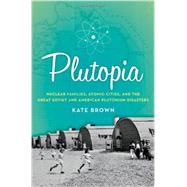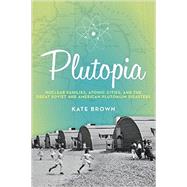Plutopia Nuclear Families, Atomic Cities, and the Great Soviet and American Plutonium Disasters

Plutopia Nuclear Families, Atomic Cities, and the Great Soviet and American Plutonium Disasters
- ISBN 13:
9780199855766
- ISBN 10:
0199855765
- Format: Hardcover
- Copyright: 04/05/2013
- Publisher: Oxford University Press
New From $26.97
Sorry, this item is currently unavailable on Knetbooks.com
List Price $27.95 Save $0.98
New
$26.97
Usually Ships in 2-3 Business Days
We Buy This Book Back!
Included with your book
Free Shipping On Every Order
Note: Supplemental materials are not guaranteed with Rental or Used book purchases.
Extend or Purchase Your Rental at Any Time
Need to keep your rental past your due date? At any time before your due date you can extend or purchase your rental through your account.
Summary
Modern utopia and nuclear wastelands come together in this history of the first two cities in the world to produce plutonium-Richland, Washington and Ozersk, Russia. Like two points on an axis, Richland and Ozersk spun around each other for four decades of Cold War in fear and rivalry. While building the massive plutonium factories, American and Soviet industrial leaders were appalled at the unruly, boozing, brawling workers constructing the plants. Independently, American and Soviet leaders realized plutonium workers could not be as volatile as the product they made. In response, leaders in both the US and USSR created plutopia-communities of nuclear families living in highly-subsidized atomic cities. In these cities, white, working class plant operators were paid and lived like middle classes. Minority workers, soldiers and prisoners, who were banned from plutopia, resided nearby in temporary staging grounds. Brown argues that by creating zones of unrivalled privilege for white plant operators, leaders of the plutonium cities forged the first citizens who willingly gave up their civil rights, political freedoms and, as they handed in their urine samples each week, rights to their bodies. In exchange they won high-risk, atomic affluence in safe, 'classless' micro-societies. Plutopia was successful because in its zoned-off isolation it appeared to deliver the promises of the American dream and Soviet communism. The exclusive communities created loyal, dependent workers who agreed not to speak of the massive plutonium disasters occurring at their plants. Medical researchers and environmental monitors colluded in keeping the silence. They buried the news of each plant's colossal dumping during the Cold War of over 200 million curies of radioactive waste into the surrounding environment. Meanwhile, farmers and indigenous communities near the plutonium plants lived off increasingly contaminated landscapes. Women endured miscarriages. In these communities, adults developed tumors and thyroid disorders. Children suffered from birth defects and childhood cancers. Many people simply felt unwell with fatigue, pain, disorders of the auto-immune and circulation system. As news broke, after the Chernobyl tragedy, of the plutonium disasters the farmers organized into the 'Downwinders' in the US and the 'White Mice' in Russia. The groups campaigned for their biological rights, insisting, in novel political campaigns, on freedom not only from want and tyranny, but from risk and contamination. In short, plutopia created not only two of the world's most radioactive territories, but also political movements confronting emergent public health epidemics, the full effects of which have yet to be tallied.









